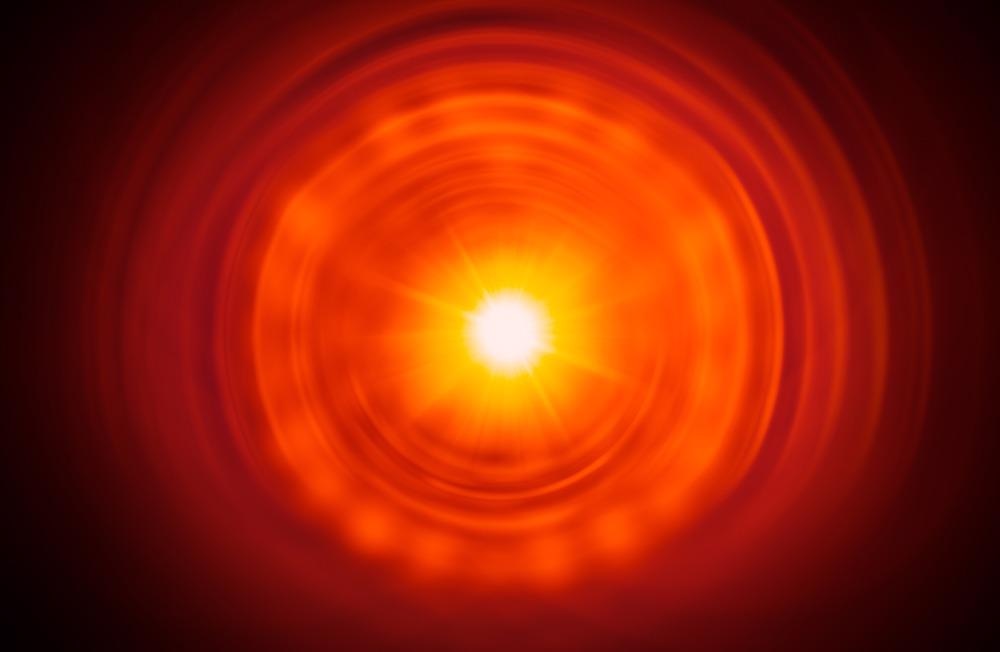Scientists have revealed that infrared wavelengths contain important information that cannot be detected easily. In this context, researchers have recently developed a molecular device that converts infrared radiation into visible light. This device enhances the sensitivity of many sensors and enables their application in different fields of science and technology.

Image Credit: Quality Stock Arts/Shutterstock.com
Electromagnetic radiation occurs in a broad range of wavelengths, i.e., from gamma rays to radio waves. Among these wavelengths, human beings are able to visualize a narrow band of wavelengths as light. This ranges from the red light of 700 nm to the violet light of 400nm. The spectral regions adjacent to the visible light wavelengths are referred to as infrared and ultraviolet rays.
Importance of Detection of Infrared Waves
Light is an electromagnetic wave that propagates through space. Every wavelength is characterized by the number of oscillations in electric or magnetic fields per second. This number is referred to as the frequency of waves and is measured in Hertz (Hz). Human eyes visualize frequencies between 400 and 700 trillion Hz (THz) and this range is known as the visible spectrum. The light sensors attached with the mobile phone cameras can sense frequencies up to 300 THz, whereas the detectors used for internet connections via optical fibers can identify frequencies up to 200 THz.
At lower frequencies, the energy transported by light is not strong enough to be sensed by photoreceptors in our eyes. This low energy is comparable to the ambient heat at room temperature. Therefore, important information available at frequencies below 100 THz, i.e., mid-and far-infrared spectrum, is not sensed easily.
Scientists have stated that both chemical and biological substances feature specific absorption frequencies in the mid-infrared range, and these can be detected remotely and non-destructively using the mid-infrared. This phenomenon could be used in many applications.
Conversion of Infrared to Visible Light
Scientists from the Valencia Polytechnic University (Spain), EPFL (Switzerland), Wuhan Institute of Technology (China), and the Institute for Atomic and Molecular Physics (Netherlands) have recently developed a new device to sense infrared light by converting its frequency to visible light. They stated that their device extends the function of the commonly available sensors of detecting visible light to the infrared region.
Another group of researchers from the University of Cambridge, in collaboration with colleagues from Belgium and Spain, exhibited a new method of sensing and converting infrared light into visible light. Both the studies have been recently published in Science.
As the frequency of light is quite fundamental, it is not easy to convert it by usual approaches, such as by reflecting light on a surface or introducing it through a filter. To achieve this feat, i.e., conversion of frequency of light, researchers added energy to infrared light with a mediator. These mediators are extremely small and vibrating molecules. In this regard, scientists introduced infrared light to these molecules where it gets converted to vibrational energy.
Instantaneously, researchers impinged a higher frequency laser beam on the same molecules to offer extra energy, which ultimately converted the vibration into visible light.
One of the challenges faced by scientists is to make sure that the vibrational molecules meet the visible light quickly. To enhance the process, the tiny vibrating molecules were compressed between metallic nanostructures that served as optical antennas. The main function of these antennas is focussing the infrared light and laser energy on the sandwiched molecules.
A New Molecular Device
A new molecular device has been developed by researchers which comprises a single layer of molecules that absorbs the mid-infrared radiation within its vibrating chemical bonds.
These tiny and vibrating molecules provide energy to visible light, which they encounter by upconverting it. Researchers at the University of Cambridge explained that the interconversion of signals between the optical and mechanical domains occurs via optomechanical interactions. They used infrared absorption and Raman scattering activity of molecular vibrations in plasmonic nano activities to exhibit frequency upconversion. The newly created visible light can then be detected via modern visible-light cameras.
Professor Christophe Galland from the EPFL, who led another similar research project, stated that their designed device has many attractive attributes. One of the most important features of this device is that all information stored in the original infrared spectrum is mapped in an intact manner onto the newly created visible light. This device offers high-resolution infrared spectroscopy to be conducted using commonly available detectors, such as those present in mobile phone cameras.
The newly designed devices are very small, i.e., about a few micrometers in length and width. Therefore, these can be incorporated into large pixel arrays. Importantly, scientists pointed out that the mechanism behind these devices or the method used in the conversion process is extremely versatile, such that they can be easily adapted to different frequencies by choosing molecules with desirable vibrational frequencies.
Wen Chen, one of the scientists in the team of researchers at Cambridge, stated that at present, the light conversion efficiency of their device is very low. The research team is currently focussing on improving the efficiency of the device so that it can be released in the commercial market soon. Some of the areas where this device could be applied include detection of contaminants, checking gas mixtures, and diagnosing cancers.
References and Further Reading
Xomalis, A. et al. (2021) Detecting mid-infrared light by molecular frequency upconversion in dual-wavelength nanoantennas. Science. 374 (6572): 1268 DOI: 10.1126/science.abk2593
Chen, W. et al. (2021) Continuous-Wave Frequency Upconversion with a Molecular Optomechanical Nanocavity. Science. 374 (6572). pp. 1264-1267. DOI: 10.1126/science.abk3106
Molecular device turns infrared into visible light. (2021) [Online] Available at: https://www.eurekalert.org/news-releases/936664
University of Cambridge (2021) Color-changing magnifying glass gives clear view of infrared light. ScienceDaily. [Online] Available at: www.sciencedaily.com/releases/2021/12/211202141433.htm
Disclaimer: The views expressed here are those of the author expressed in their private capacity and do not necessarily represent the views of AZoM.com Limited T/A AZoNetwork the owner and operator of this website. This disclaimer forms part of the Terms and conditions of use of this website.